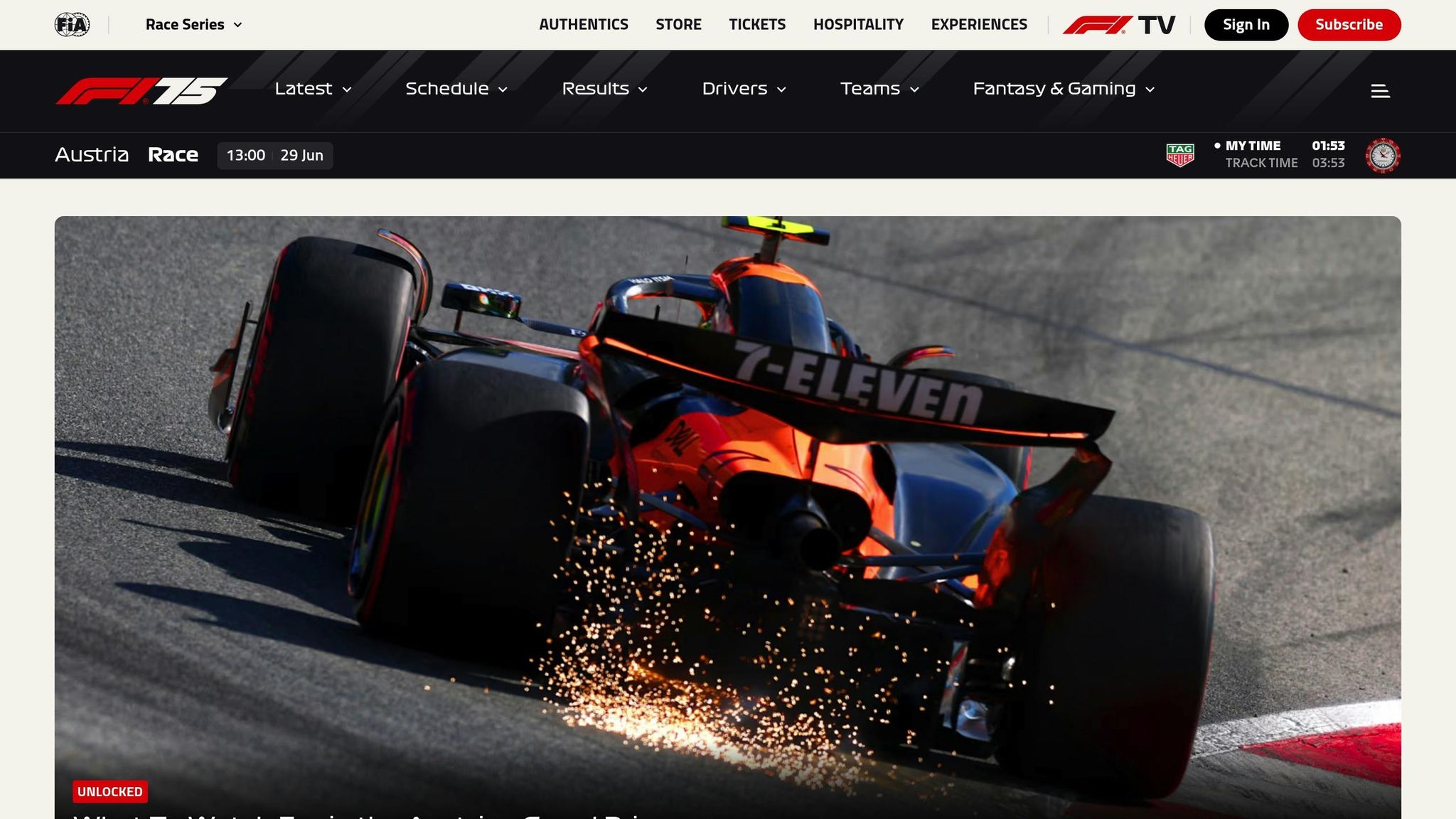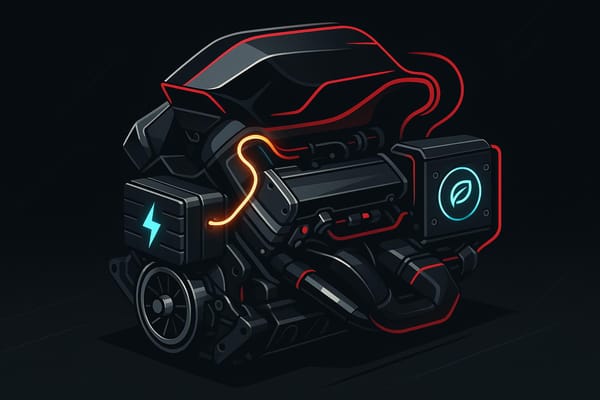Marina Bay Circuit: The Origins and Evolution of Singapore’s Iconic Night Grand Prix
Explore the evolution of Singapore's Marina Bay Circuit, the first night race in Formula One, and its lasting impact on motorsport and tourism.

The Marina Bay Circuit in Singapore transformed Formula One by hosting its first night race in 2008. This event marked a turning point for the sport, blending high-speed street racing with the dazzling backdrop of Singapore's skyline. Night racing solved two major challenges: it provided relief from Singapore's intense heat and catered to European TV audiences. The circuit, designed by Hermann Tilke and refined by KBR, Inc., cost $24.5 million to develop and set new standards for urban racing.
Key highlights include:
- Track Features: A 3.07-mile circuit with 19 corners, requiring precise engineering and advanced lighting systems delivering 3,000 lux.
- Economic Impact: Singapore invested heavily, with 60% of costs covered by the government, aiming to boost tourism and global recognition.
- Historic Moments: Infamous incidents like "Crashgate" in 2008 and dramatic races in 2010 and 2017.
- Global Influence: Inspired other night races, such as those in Bahrain and Las Vegas, and reshaped F1's global appeal.
The Marina Bay Circuit continues to challenge drivers with its demanding layout and tropical conditions, solidifying its place as a standout event in Formula One history.
The Singapore Grand Prix Formula 1: SECRETS and HISTORY They Won't Tell You
How the Marina Bay Circuit Was Created

The Marina Bay Circuit emerged from an ambitious plan to position Singapore as a global motorsport hub. This vision took shape when Bernie Ecclestone, Mr. Ong Beng Seng, and the Singapore Tourism Board secured a five-year agreement to bring Formula 1 to Singapore. This collaboration marked a turning point, showcasing Singapore as a leader in Formula 1 innovation. The journey from concept to reality involved thorough planning and cutting-edge design.
The Original Plan for the Circuit
Singapore's entry into Formula 1 aimed to boost international tourism and viewership. The goal was to establish the city as a must-see destination for travelers and motorsport fans alike. With its modern infrastructure and cosmopolitan appeal, Singapore offered something distinct for the Formula 1 calendar. S Iswaran captured this vision, saying:
"We envision it to be a national festival, and one that presents many opportunities for participation for everyone, both visitors and Singaporeans alike".
But the event was designed to be more than just a race. It became a multi-day celebration, featuring performances by global stars like Katy Perry, Maroon 5, and Shakira, turning the F1 Padang stage into a unique highlight of the Formula 1 experience.
Circuit Design and Planning Process
Transforming Singapore's city streets into a high-speed race track was no small feat. Renowned circuit designer Hermann Tilke laid the groundwork for the design, which was later refined by KBR, Inc. to address the practical challenges of building a street circuit in an urban environment. The project came with a price tag of around S$33 million (approximately $24.5 million USD), reflecting Singapore's commitment to creating a world-class venue.
The 3.07-mile (4.940-km) circuit snakes through the Downtown Core and Kallang areas, incorporating key roads like Republic Boulevard and Nicoll Highway. With 19 demanding turns, the design pushed the boundaries of what was possible in an urban setting. Bernie Ecclestone acknowledged the complexity of the task:
"We are looking into all the problems and trying to find ways to solve them... If we don't get it done, it won't get done".
The design not only overcame urban constraints but also set a new standard for Formula 1 circuits. These challenges directly influenced the decision to race at night, blending innovation with practicality.
Why Singapore Chose a Night Race Format
Hosting Formula 1's first night race was a bold and strategic move. This decision reshaped the sport, inspiring other night races like the Las Vegas and Qatar Grands Prix by 2023. The night format wasn't just about spectacle; it addressed local challenges, such as Singapore's tropical heat, while enhancing the global appeal of the event.
The Singapore Grand Prix has also made a lasting impact beyond the track. Since its debut in 2008, it has raised $3.86 million for charitable causes and engaged nearly 100,000 students through educational programs on Formula 1. By tackling urban and environmental challenges, Singapore introduced innovations that continue to influence the sport on a global scale.
The creation of the Marina Bay Circuit was a masterclass in ambition, expertise, and strategy. Singapore didn't just aim to host a race - it redefined what a Grand Prix could be, setting a benchmark that continues to shape Formula 1 today.
Building the World's First Night Grand Prix
Creating Formula 1's first night race was no simple task - it meant tackling technical challenges that had never been faced before. Transforming Singapore's vibrant city streets into a high-speed racing circuit required groundbreaking engineering and meticulous planning, pushing the limits of what was possible in motorsport infrastructure.
Converting City Streets into a Race Track
Turning Singapore's bustling urban roads into a Formula 1-grade circuit was a monumental logistical challenge. With a workforce of 25,000, the project demanded precision and innovation at every step.
One of the most demanding aspects was preparing the track surface. United E&P, a local contractor, collaborated with Topcon Positioning Systems to meet the strict standards required for Formula 1 racing. Using advanced laser scanning technology and software tools like MAGNET and RD-M3, the team meticulously modeled and milled the track surface to exact specifications. Graham Castle, Construction Manager at United E&P, described the painstaking attention to detail:
"The tolerances on this job are very tight. We have a riding index we have to meet, a +/- 3 millimetre tolerance on our levels and also 3 millimetre tolerance under a four metre straight edge for the paved surface."
To boost safety and performance, the track was treated with a polymer binder that enhanced grip by 20%.
Time constraints added another layer of difficulty. With road closures limited to a narrow window from 1 a.m. to 5 a.m., crews had just four hours each night to complete their work. Castle noted the intense pressure this created:
"Normally we don't get road closure until 1am and the road must be open at 5am, so completing the work in four hours is intensely challenging."
Additionally, safety infrastructure was a massive undertaking. Around 7,000 barriers and over 62 miles (100 km) of cables were installed along the 3.07-mile (4.94 km) circuit, turning ordinary streets into a world-class racing venue.
Advanced Lighting Systems and Safety Measures
One of the standout features of Singapore's night race was its cutting-edge lighting system. Engineers designed a setup capable of delivering 3,000 lux of light intensity - four times brighter than most football stadiums. This required a staggering 3,180,000 watts of power. The system included 240 steel pylons and approximately 1,700 floodlight projectors, connected by over 62 miles (100,000 meters) of power cables.
The lighting was carefully designed to ensure consistent illumination across the track and run-off areas, eliminating shadows and reflections that could pose risks, especially in wet conditions. Jonathan Hallett, Race Communications Director, explained the focus on driver safety:
"Safety is of utmost concern to us, thus great care has been taken to develop a lighting system that is bright enough for night race conditions, and at the same time will not cause any glare for the drivers."
Race Infrastructure and Facilities
Beyond the lighting, the circuit's infrastructure had to meet the rigorous demands of Formula 1. Temporary and permanent structures were built to support the event, including grandstands with a capacity for 90,000 spectators.
The pit complex and paddock facilities were designed to accommodate the needs of the 10 Formula 1 teams, along with their equipment, mechanics, engineers, and support staff. These facilities had to be assembled and disassembled quickly, as the circuit reverted back to public road use between race weekends. Special attention was also given to camera placement and broadcast lighting to ensure the race met international television standards.
Mathew Connelly, Aptella Manager for South East Asia, highlighted the reliance on technology to meet tight deadlines:
"We're really using every bit of technology we have at our disposal for this job to give a great result in a limited amount of time."
The cost of building the circuit reflected its complexity and scale. Singapore invested S$33 million (about $24.5 million USD) to bring this groundbreaking racing venue to life.
Circuit Changes and Historic Moments
The Marina Bay Circuit has come a long way since its debut in 2008. Over the years, the track has undergone several changes, driven by the need to improve safety, enhance racing quality, and adapt to urban development. These adjustments haven't just made the circuit safer and more exciting for racers; they've also set the stage for some of the most unforgettable moments in Formula 1 history.
Major Track Layout Changes
When the circuit opened in 2008, it featured 23 corners and stretched 3.15 miles (5.063 km). By 2023, the layout had been refined to 19 corners over 3.06 miles (4.928 km). The first layout change came in 2009, when the pit lane exit was adjusted at Turn Two, and Turn One was tightened. In 2013, the infamous "Singapore Sling" chicane at Turn 10 was replaced with a single-apex left-hand bend, increasing speeds at the corner by about 25 mph (40 km/h). Lewis Hamilton famously called it "the worst corner in F1."
Further updates followed in 2015, with Turn 11 being tightened, Turn 12 modified for a smoother approach to Turn 13, and Turn 13 itself widened by about 1 meter to encourage overtaking. In 2018, the final sector saw slight tweaks to Turns 16 and 17, which shortened the track length slightly from 5.065 km to 5.063 km.
The most dramatic transformation came in 2023 due to urban redevelopment. The construction of "NS Square" at Marina Bay required removing the Bay Grandstand section. This change led to a new straight connecting Turns 16 and 19, eliminating the previous Turns 17 and 18. To maintain the race's overall distance, two additional laps were added to the Grand Prix. Reflecting on these changes, Riccardo Musconi, Head of Trackside Performance at Mercedes-AMG Petronas F1 Team, shared his perspective:
"It certainly changes the flavour of that final sector".
Most Memorable Races and Events
Marina Bay has hosted some of Formula 1's most dramatic and controversial moments, with 24 safety car deployments across 15 races. The inaugural race in 2008 remains infamous for "Crashgate", where Nelson Piquet Jr.'s deliberate crash helped Fernando Alonso secure victory, while a botched pit stop dashed Felipe Massa's hopes of a win.
In 2010, Alonso and Sebastian Vettel delivered a nail-biting showdown, with Alonso narrowly coming out on top. The 2014 race was a thriller, featuring four lead changes among three drivers before Lewis Hamilton clinched victory. The 2017 Grand Prix brought chaos with a dramatic first-lap collision involving Vettel, Max Verstappen, and Kimi Räikkönen, taking out three championship contenders and handing the lead - and the win - to Hamilton.
Simon Ostler summed up the circuit's unique challenges and appeal:
"The Singapore Grand Prix has remained a fixture on the F1 calendar (barring two years off during the pandemic) however is largely down to the racing we've had there. The circuit, coupled with extreme climate conditions, is one of the toughest challenges of the year for the drivers, who regularly deal with temperatures exceeding 122°F (50°C). On top of that, Marina Bay has been the backdrop for some truly dramatic moments, some of which have had world championship deciding connotations".
Marina Bay's Impact on Formula One

The Marina Bay Circuit has left a lasting mark on Formula One, reshaping race strategy, marketing, and the overall entertainment experience. Since its introduction in 2008, Singapore's night race has grown into a standout event, testing the limits of teams, drivers, and fans alike.
How the Circuit Affects Race Strategy
With its 19 corners packed into just 3.07 miles, Marina Bay forces teams to rethink their race strategies, especially after recent changes to the track. The limited opportunities for overtaking make qualifying sessions incredibly important, as polesitters often dominate the race.
Pit stops are another critical factor. A stop here costs 28 seconds - one of the steepest time losses in the season. This makes timing pit stops a high-stakes decision. Add to that the near certainty of safety car deployments, and teams have to carefully balance tire choices and race timing.
Tire management takes on even greater importance at Marina Bay. Mario Isola, Pirelli's Head of Motorsport, sheds light on the challenge:
"This track doesn't place particular stress on the tyres in terms of loading, but the rear tyres need to be carefully managed during the traction phase when exiting slow corners. Temperatures are usually consistently high, as Singapore is only about 150 kilometers from the equator. This increases the risk of overheating: not just for tyres but also everything else, including the mechanicals and of course the driver!"
The tropical heat adds another layer of complexity. With ambient temperatures often topping 104°F (40°C) and cockpit temperatures soaring to 140°F (60°C), drivers can lose as much as 4 kg (8.8 pounds) of body weight during the race.
Kevin Magnussen of Haas describes the relentless nature of the circuit:
"It's one of the toughest races because of the weather and also just because the track layout is how it is with corner, after corner, after corner without any rest. On most tracks, you get a couple of straights around the lap where you can get a breather but in Singapore, even on the so-called straight, it's still kind of turning. It's also very bumpy so you can't really relax."
The two-hour race limit has been reached five times at Marina Bay, illustrating how the circuit pushes teams to find a delicate balance between speed and reliability. These challenges go beyond the technical aspects, contributing to Formula One's growing appeal on a global scale.
Growing F1's Worldwide Audience
Marina Bay's night race format has changed the game for Formula One, influencing how the sport is broadcast and experienced worldwide. As the first night race on the F1 calendar, it set the stage for more night events in the future. Its timing also caters to European and American audiences, offering prime-time viewing slots.
Visually, the race is a spectacle. With around 1,600 custom-made floodlights illuminating the track, the event creates stunning visuals that highlight Formula One's glamour and technical sophistication. The circuit's location in Southeast Asia has also opened doors to new audiences and turned the race weekend into a major social and business occasion, rivaling Monaco's prestige in Europe.
Efforts to reduce the event's environmental impact have further boosted its reputation. In 2022, 85% of the electricity used by the grid was carbon neutral, reflecting Formula One's growing commitment to sustainability.
Night Racing Benefits and Drawbacks
The night race format brings unique advantages and challenges, influencing both circuit design and scheduling decisions:
| Factor | Benefits | Drawbacks |
|---|---|---|
| Temperature | Cooler air improves engine performance and reduces overheating risks | Cockpit temperatures still reach 140°F (60°C); high humidity persists |
| Visibility | Advanced lighting creates spectacular visuals for broadcasts | Shadows and reduced peripheral vision can make driving more difficult |
| Broadcast Timing | Prime-time slots for European and American viewers | European time zones disrupt paddock staff schedules |
| Track Conditions | Consistent lighting eliminates sun glare issues | Artificial lighting can affect drivers' depth perception |
| Fan Experience | Cooler evenings enhance spectator comfort | Limited natural light impacts photography and viewing quality |
Despite the cooler evening temperatures, the race remains physically punishing. Even Lewis Hamilton, who once said, "The track is epic to drive", acknowledges the immense challenges it presents. Additionally, operating on European time zones adds logistical hurdles for teams and staff.
Marina Bay's success as a night race demonstrates how Formula One can adapt its traditional daytime format to deliver thrilling entertainment. By blending competitive racing with innovative presentation, the event has not only maintained the sport's integrity but also expanded its global appeal.
Conclusion
Marina Bay forever changed the face of Formula One with its debut night race in 2008, seamlessly combining urban aesthetics with advanced technology. Over the years, Singapore's street circuit has become a cornerstone of the sport, thanks to its demanding track design, cutting-edge lighting systems, and efforts toward sustainable energy use.
This circuit is known for pushing drivers to their limits - physically and mentally. During the race, drivers endure intense conditions, often losing between three to four kilograms of body weight. Adding to its reputation, Marina Bay has consistently presented operational challenges, with every race up to 2024 featuring at least one Safety Car deployment.
The success of Singapore’s night race has had a ripple effect across Formula One. It inspired other venues, like Bahrain in 2014 and Abu Dhabi with its day-to-night format, to adopt similar approaches. These shifts have helped redefine how Formula One events are staged, solidifying Marina Bay’s influence on the sport’s evolution.
Beyond the race itself, the Singapore Grand Prix has become a global spectacle, blending motorsport with entertainment. Iconic performances by stars such as Katy Perry, Maroon 5, and Shakira have added to its vibrant appeal. By setting new benchmarks in circuit design, broadcast timing, and fan experiences, Marina Bay continues to captivate audiences worldwide while driving Formula One into the future.
FAQs
How did hosting the first night race at the Marina Bay Circuit impact Formula 1 globally?
The Marina Bay Circuit made history as Formula 1's first-ever night race, changing the game for the sport. Hosting the event after sunset not only added a dramatic flair but also made it more accessible to a global audience. By scheduling the race to suit European time zones, it drew in more viewers while offering cooler temperatures for both drivers and fans.
This milestone event encouraged other circuits, especially in warmer regions, to explore the concept of night racing. On top of that, Singapore's innovative use of energy-efficient lighting raised the bar for sustainability in motorsport, driving forward new technologies and operational practices throughout Formula 1.
What challenges did engineers face in transforming Singapore's streets into the Marina Bay Circuit, and how were they resolved?
Transforming Singapore's vibrant city streets into the Marina Bay Circuit was no small feat. The city's compact and intricate urban design posed a significant challenge, requiring creative solutions to meet the rigorous safety and performance standards of Formula 1. Engineers had to strike a delicate balance - designing a track with tight, technical corners while also incorporating stretches that allowed for overtaking, ensuring the races remained thrilling without compromising driver safety.
Hosting a night race added another layer of complexity. Advanced lighting systems had to be installed to replicate daylight conditions, providing clear visibility for drivers and an electrifying experience for spectators. On top of that, the city's humid climate demanded careful planning to ensure the track could handle the unique weather challenges. Through meticulous engineering, thoughtful modifications, and the integration of advanced technologies, the Marina Bay Circuit emerged as a premier destination for Formula 1 night racing.
What impact has the Marina Bay Circuit had on Singapore's tourism and economy since its debut in 2008?
Since its debut in 2008, the Marina Bay Circuit has transformed Singapore's tourism landscape and economy. The annual night race attracts over 550,000 international visitors each year, contributing an impressive $1.5 billion in tourism revenue. This surge of global tourists has been a boon for local businesses, created thousands of jobs, and reinforced Singapore’s standing as a top-tier destination for luxury travel, business, and entertainment.
But the impact goes far beyond tourism. The event has elevated Singapore’s international profile by proving its capability to host large-scale, cutting-edge events. As a standout feature on the Formula One calendar, the Marina Bay Circuit has become a symbol of innovation and grandeur, further cementing the city-state’s reputation as a leading global hub.
Related posts
- Monaco Grand Prix Circuit Guide: The Prestige, Precision, and Pressure of F1’s Crown Jewel
- Albert Park Uncovered: The History, Evolution, and Challenges of the Australian Grand Prix Circuit
- Jeddah Corniche Circuit: The High-Speed Street Track Redefining Night Racing in Saudi Arabia
- Miami International Autodrome: The Newest Showstopper in F1’s American Dream




